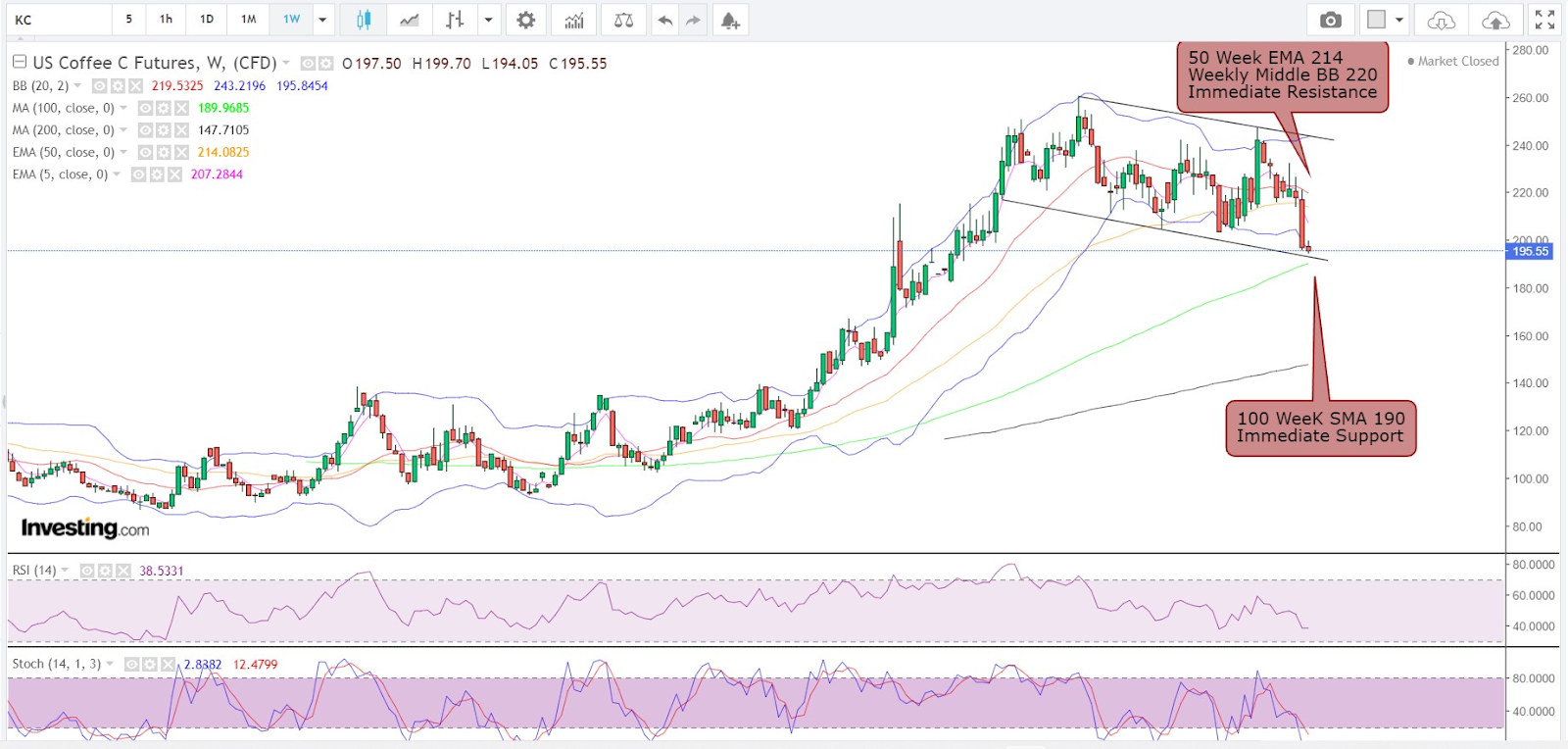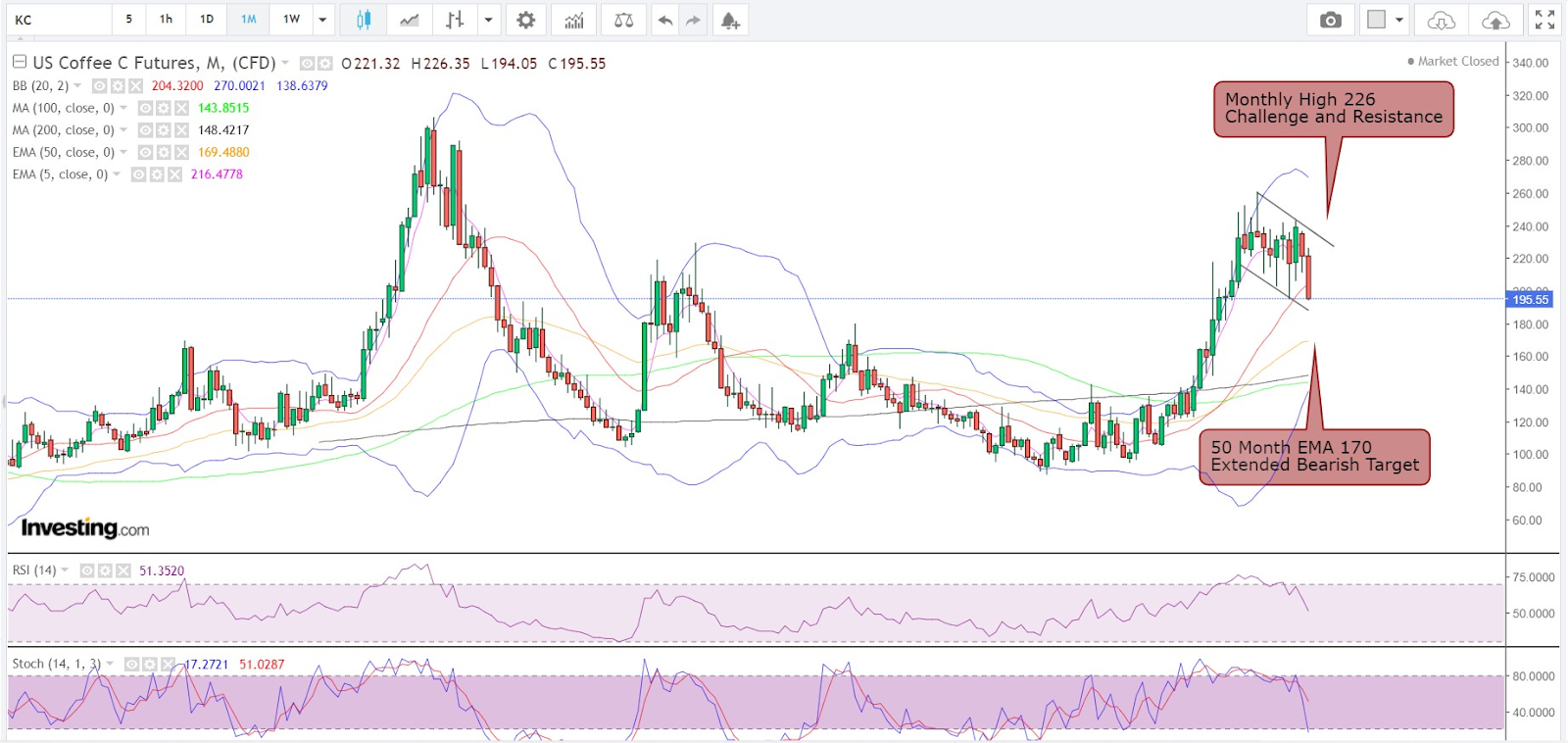- Arabica coffee down 12% so far for Oct, the most since 13% drop in Sept 2020
- Brazil has harvested too much and more beans could be coming ahead of La Nina
- $1.90 might be a support, otherwise low of $1.70 could be on cards
- Oversold conditions could lead to rebound toward $2.25 and $2.20
The price of arabica futures, the coffee bean prized by Starbucks (NASDAQ:SBUX), is going down the tubes even as the world's top coffee chains are making their lattes, mochas, and other espresso drinks more expensive.
The disconnect seems to be with the actual supply of arabica itself: those in the trade say there's been too much harvested of late by the No.1 grower, Brazil—and benign coffee weather in South America could mean more beans are coming.
"The market thinks that coffee is in good supply world wide," said Jack Scoville, head of research for coffee and other crops at Chicago brokerage Price Futures Group.
Scoville said there was still a threat for a third year of La Niña, the weather pattern that typically disrupts crop output by bringing too much rain. Adding:
"This could negatively affect Coffee production again next year but so far the crop conditions are called good."
A look at arabica's trade on New York's Intercontinental Exchange (ICE) tells the story of a raw material that could not be more different from the popularity of its products in the marketplace.
All charts courtesy of SKCharting.com with data from Investing.com
Arabica hit a one-year low of $1.9405 an lb in Monday's trade. With less than two weeks left for October and without a pick up from where it is, the bean risks finishing the month with its biggest loss in two years—almost 12% versus the September 2020 drop of 13%.
Starbucks reported better-than-expected quarterly earnings and revenue in August, fueled by what it said was demand in the U.S. for its cold coffee drinks.
As inflation surges, Starbucks founder and interim CEO Howard Schultz said the chain is not seeing customers trade down or reduce their spending. Schultz credited Starbucks' pricing power and customer loyalty for its ability to buck the trend.
Rabobank has been saying the weather in Brazil has been excellent for the flowering of the coffee crop due to be harvested next year. Last month, the Netherlands-headquartered bank, said the weather in Brazil has been excellent for the flowering of the coffee crop due to be harvested next year.
Brazil's government also admitted in September that its estimates for coffee crops over recent years have had problems and need improvement to better reflect reality since the numbers for production have been smaller than the sum of local consumption plus exports.
In an interview with Reuters, the director of Agricultural Policy at Brazil's food supply and statistics agency Conab, Sergio De Zen, said that due to those discrepancies there is a process going on to revise numbers and methodology for Conab's coffee crop forecasts.
Conab's coffee numbers for Brazil, the world's largest producer, and exporter, have for years been the subject of debate among coffee traders and analysts, who generally consider production estimates to be too low.
Trading houses and independent analysts usually have higher crop numbers for Brazil than Conab. For this year, for example, while Conab sees the crop at 50.4 million 60 kg bags, the U.S. Department of Agriculture (USDA) expects 64.3 million, Rabobank sees 63.2 million, and consultancy Safras & Mercado, 58.2 million bags.
"We've been talking to co-ops, farmers and exporters, trying to work together to be able to have a crop projection that better reflects the reality," said De Zen.
The director's comments came after Reuters questioned Conab's forecasts with numbers for Brazil's consumption and exports. There is a clear supply gap when they are compared.
When numbers for local consumption plus exports are compared with crop projections for the last five years there is a large deficit of more than 32 million bags.
"We've done that calculation before..." the director said, admitting to the problem.
Stock numbers could help solve the equation, but Conab has stopped publishing those.
"We have not published them because the supply balance calculation does not make sense," he said, confirming the gap.
De Zen said, however, that stocks at farms are not negligible and could help to solve the S&D equation, but he said the number and quality of answers to the stocks poll were low.
So, where could arabica prices be heading in the near term, at least technically?

According to Sunil Kumar Dixit, chief technical strategist at SKCharting.com, arabica was trading within a descending channel near support.
"The 100-week SMA of $1.90 may act as pro temp support," Dixit said, referring to the Simple Moving Average.
He added that the 50-Week Exponential Moving Average of $2.14 and the weekly Middle Bollinger Band of $2.20 were immediate resistance zones for the short term.
"Coffee's bearish trend may extend beyond the 100 week SMA of 190 and find support a little deeper around the $1.70 level, which corresponds to the 50-month EMA," Dixit said.
On the flip side, oversold conditions in Weekly Stochastics may help prices in the short term rebound towards $2.25 and $2.20, he said.
Disclaimer: Barani Krishnan uses a range of views outside his own to bring diversity to his analysis of any market. For neutrality, he sometimes presents contrarian views and market variables. He does not hold positions in the commodities and securities he writes about.
